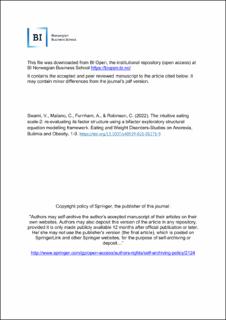| dc.contributor.author | Swami, Viren | |
| dc.contributor.author | Maïano, Christophe | |
| dc.contributor.author | Furnham, Adrian | |
| dc.contributor.author | Robinson, Charlotte | |
| dc.date.accessioned | 2023-09-28T10:20:25Z | |
| dc.date.available | 2023-09-28T10:20:25Z | |
| dc.date.created | 2021-10-27T19:45:20Z | |
| dc.date.issued | 2021 | |
| dc.identifier.citation | Eating and Weight Disorders. 2021, . | en_US |
| dc.identifier.issn | 1124-4909 | |
| dc.identifier.uri | https://hdl.handle.net/11250/3092654 | |
| dc.description.abstract | Purpose Previous studies examining the appropriateness of the 4-factor model of intuitive eating scale-2 (IES-2) scores have returned equivocal results, which may reflect methodological limitations in the way IES-2 scores are modelled. Here, we applied a bifactor-exploratory structural equation modelling (B-ESEM) framework to better understand IES-2 multidimensionality. Methods A total of 603 participants from the United States completed the IES-2, alongside measures of body appreciation, body acceptance from others, and self-esteem. Our analyses compared the fit of various hypothesised models of IES-2 scores. Results Models of IES-2 scores based on confirmatory factor analysis (CFA) uniformly showed poor fit. ESEM models showed superior fit to CFA representations and a B-ESEM model showed improved fit over higher-order CFA and B-CFA representations of IES-2 scores. The optimal model was a B-ESEM model that accounted for, through correlated uniqueness (CU), the methodological artefact introduced by negatively-worded IES-2 items. This B-ESEM-CU model was fully invariant across gender and showed adequate construct validity. Conclusion The B-ESEM-CU framework appears well-suited to understand the multidimensionality of IES-2 scores. A model of IES-2 scores that yields a reliable latent indicator of global intuitive eating while allowing for simultaneous consideration of additional specific factors will likely provide more accurate accounting of the nature and outcomes of intuitive eating. Level of evidence Level III, cohort study. | en_US |
| dc.language.iso | eng | en_US |
| dc.publisher | Springer | en_US |
| dc.rights | Navngivelse 4.0 Internasjonal | * |
| dc.rights.uri | http://creativecommons.org/licenses/by/4.0/deed.no | * |
| dc.subject | Intuitive eating | en_US |
| dc.subject | Intuitive eating scale-2 | en_US |
| dc.subject | Exploratory structural equation modelling | en_US |
| dc.subject | Bifactor analysis | en_US |
| dc.subject | Correlated uniqueness | en_US |
| dc.title | The intuitive eating scale-2: re-evaluating its factor structure using a bifactor exploratory structural equation modelling framework | en_US |
| dc.title.alternative | The intuitive eating scale-2: re-evaluating its factor structure using a bifactor exploratory structural equation modelling framework | en_US |
| dc.type | Peer reviewed | en_US |
| dc.type | Journal article | en_US |
| dc.description.version | acceptedVersion | en_US |
| dc.rights.holder | Springer | en_US |
| dc.source.pagenumber | 9 | en_US |
| dc.source.volume | 27 | en_US |
| dc.source.journal | Eating and Weight Disorders | en_US |
| dc.identifier.doi | 10.1007/s40519-021-01271-9 | |
| dc.identifier.cristin | 1949080 | |
| cristin.ispublished | true | |
| cristin.fulltext | postprint | |
| cristin.qualitycode | 1 | |

